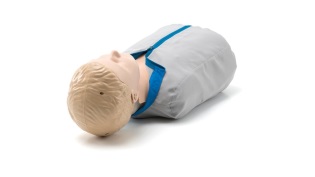- Products >> CPR Manikins>> Little Junior QCPR


Little Junior™ QCPR
With objective feedback and scoring, learners are motivated not only to compete with one another, but also to try to beat their own best score. The competition element makes training more engaging and interactive and has been demonstrated to improve motivation.3 In addition to the traditional way of using performance metrics to display a score at the end of the session, Little Junior QCPR can also be used to run QCPR Race, a completely new and innovative way of engaging learners in CPR training.

Measure to improve:
Little Junior QCPR allows an instructor to monitor up to six learners at the same time from the palm of their hand. The QCPR Instructor App provides an easy to view performance summary that highlights which students may require further guidance. At a glance, you can see who is not compressing deeply enough, who is not compressing at the correct rate and who is over ventilating. Students can monitor their own performance with the QCPR Learner app or the tethered SkillGuide device. QCPR measurement and feedback technology enables:- Real-time feedback on compressions and ventilations
- Post-training debrief, including overall scores and tips for improvement
- Details on compression release, depth and rate, ventilation volume, and number of compressions, ventilations and cycles
Product benefits:
- Educationally effective by offering all of the essential features necessary for learning child CPR.
- Affordability through increased hands-on practice by allowing higher student-to-manikin ratios.
- Realistic anatomical landmarks provide the essential features necessary to teach quality appropriate CPR techniques.
- Logistically convenient lightweight design makes Little Junior easy to transport.
- Durable construction allows unequalled long-term use.
Product features:
- Oral and nasal passages allow realistic nose pinch required for mouth-to-nose and mouth-to-mouth ventilation.
- Natural obstruction of the airway allows students to learn the important technique of opening the airway. Abdominal thrusts can also be practiced.
- Head tilt/chin lift and jaw thrust allow students to correctly practice all maneuvers necessary when resuscitating a real victim.
- Realistic airway function means that the airway remains obstructed without proper head tilt/chin lift or jaw thrust. Chest rise is seen with correct ventilations.
- Anatomically correct landmarks and sternal notch allow the student to practice identification of all anatomical landmarks relevant to child CPR.
- Audible feedback for chest compressions reinforces correct compression depth with an optional “clicker” feature.
- Realistic chest compression resistance allows the students to experience the amount of pressure needed to perform proper chest compressions in a real-life situation.
- Economical disposable airways for quick and easy clean-up.
- Removable and reusable faces for convenient and affordable maintenance.
Useful docs about the product
Product Number:
128-01050 Little Junior QCPR
129-03050 Little Junior QCPR (pack of 4)
128-60750 Upgrade kit (for old Little Junior)
Consumables:
020310 Little Anne Valve with Filter
15120103 Manikin Face Shield
152400 Manikin Wipes
152401 Manikin Wipes
183010 Face Mask Little Junior
183210 Airway Complete Little Junior
183211 Airway Complete Little Junior
183220 Filter and Lung
Apps:
Learners
 36 Α Taxiarchon Str, Kalamaki
36 Α Taxiarchon Str, Kalamaki